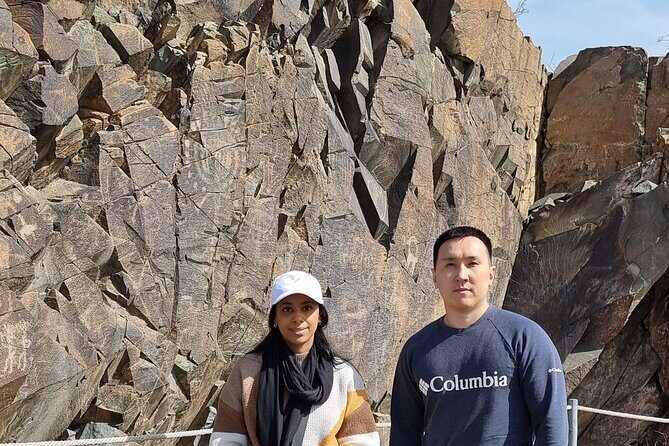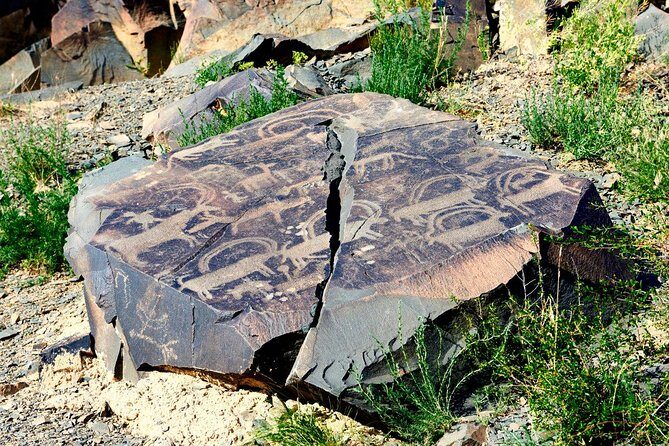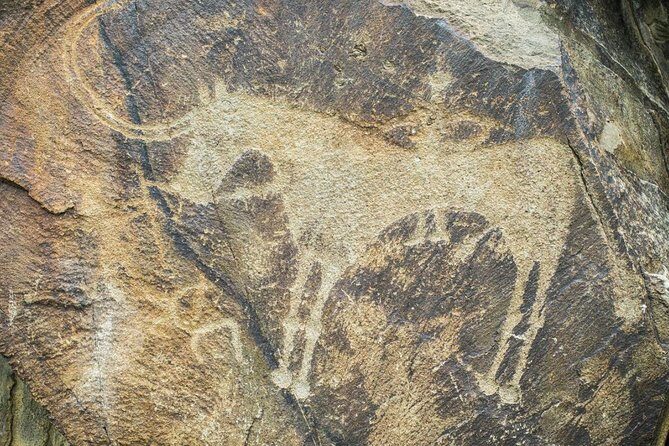Day Trip to Tanbaly Petroglyphs – A Closer Look
This day-long adventure takes you from Almaty to the Tanbaly Museum-Reserve, a site renowned for its extensive collection of prehistoric petroglyphs. Priced at $221.57 per group of up to four, the tour lasts around eight hours, including a scenic three-hour drive. You’ll explore six different groups of petroglyphs that span from the Bronze Age to the XIV century, making it a true window into the distant past. The tour includes hotel pickup, bottled water, and all entrance fees, with the only major extra being lunch.
What we appreciate most about this experience is how it combines cultural discovery with nature’s beauty—the reserve covers a vast terrain of hills, canyons, and rocks, making the scenery as engaging as the art itself. The site’s UNESCO World Heritage status underscores its global importance, and learning about the different eras represented in the petroglyphs gives visitors a layered understanding of Kazakhstan’s history. Plus, the air-conditioned vehicle keeps the journey comfortable despite the long drive.
However, there are some considerations. Both reviews point out that the site’s conservation efforts leave something to be desired—fewer interpretative signs and less protection than one might hope for. Also, the guides’ English skills seem to vary, which could affect the depth of commentary, especially if you’re keen on detailed explanations. This tour may suit those who are curious about ancient art but don’t mind a bit of rough-around-the-edges presentation.
In all, this trip is best for travelers interested in archaeology and history, who are comfortable with a longer drive and somewhat minimal site infrastructure. It’s also perfect for those looking to experience Kazakhstan’s cultural richness beyond the city, even if the site isn’t perfectly preserved.
Key Points

- Cultural treasure: The petroglyphs span from the Bronze Age to the 14th century, offering a broad view of ancient Kazakh life.
- UNESCO-listed: Recognized for its historical significance, the site is a must-see for archaeology enthusiasts.
- Long but scenic drive: The three-hour drive is a chance to see Kazakhstan’s landscape, but be prepared for the journey.
- Limited site infrastructure: Few interpretive signs and less conservation mean you’ll need to do some imagination and rely on guides.
- Comfortable transport: An air-conditioned vehicle makes the long day more bearable.
- Authentic experience: The site’s natural setting and ancient carvings provide a genuine glimpse into the past, despite some conservation drawbacks.
An In-Depth Look at the Experience
While in Almaty, here are other experiences we've covered
Starting Out: Convenience and Comfort
The tour begins with hotel pickup at 9:00 am, a straightforward start for those staying in Almaty. The air-conditioned vehicle promises a comfortable journey, especially considering the approximately three-hour drive each way. The group operates privately, meaning your party won’t be sharing the experience with strangers—an advantage for personalized exploration.
The Journey: Scenic Kazakhstan
While the drive may seem lengthy, it’s part of the adventure. Kazakhstan’s landscape unfolds outside your window—mountains, canyons, and open terrain that make the trip itself worth the while. As one reviewer noted, “Although it was a long drive, the petroglyphs were interesting,” highlighting that the journey is both scenic and part of the experience.
The Main Event: Tanbaly Museum-Reserve
The reserve covers a vast area with hills, canyons, and rocky outcroppings, each hiding clusters of prehistoric carvings. There are six groups of petroglyphs, each from different eras, providing a layered historical record. The museum-reserve was inscribed on the UNESCO World Heritage List in 2004, confirming its global importance.
During the approximately three hours at the site, you’ll wander among the carvings—some depicting animals, human figures, symbols, and scenes that are believed to record hunter-gatherer activities, spiritual beliefs, or early astronomical knowledge. Your guide will point out some highlights, but as reviews suggest, interpretative signage is sparse.
One visitor expressed frustration: “There are few interpretative signs,” which might leave some visitors wishing for more context. Still, the rawness of the site and the sense of stepping back thousands of years make it worthwhile. You’ll learn that some petroglyphs date back to the Bronze Age, while others are from the XIV century, offering a fascinating timeline.
The Site’s Conservation and Guide Quality
A recurring theme from reviews is that the site isn’t well conserved or protected. There are concerns that some carvings may be deteriorating, and the lack of signage means that you may find it challenging to fully understand the significance of what you’re seeing. Plus, a reviewer noted that the guide’s English wasn’t particularly strong, resulting in missed commentary and some confusion during the visit.
However, the guide will still share stories and basic explanations, and your own curiosity can fill in the gaps. The driver’s kindness was also appreciated—he even offered local-made snacks since nearby amenities are nonexistent, adding a touch of local hospitality.
Practical Tips and What to Expect
- Bring water and wear comfortable shoes—walking around uneven terrain is inevitable.
- Expect minimal facilities: There are no cafes or shops on-site, so snacks provided by the driver are a nice gesture.
- Timing: You’ll need to be prepared for a full day out, including the drive and the exploration.
- Photography: The landscape and carvings make for excellent photo opportunities, especially early or late in the day when lighting is softer.
- For history buffs: Despite conservation issues, the chance to see ancient art in its natural setting is compelling.
Who Should Consider This Tour?
This trip appeals most to travelers interested in archaeology and history, willing to tolerate rougher site conditions and basic interpretive infrastructure. It’s suitable for those who enjoy long scenic drives and are comfortable with a more rustic experience. If you’re looking for a polished, high-tech museum environment, this might not be for you. But if you want to stand among ancient carvings and imagine the lives of early peoples, it’s a window into the distant past you won’t want to miss.
The Sum Up

The Day Trip to Tanbaly Petroglyphs offers a unique opportunity to glimpse Kazakhstan’s ancient history in a remarkably scenic setting. While not the most polished site—lacking extensive signage and conservation—the authenticity of the carvings and the natural landscape provide a compelling backdrop to this archaeological journey. The long drive can be a drawback for some, but it’s also part of the adventure, taking you through Kazakhstan’s diverse terrain.
This tour is best suited for history enthusiasts, adventurers willing to explore slightly rugged sites, and those eager to see UNESCO-listed attractions with a genuine feel. Expect an experience that combines cultural discovery with the beauty of Kazakhstan’s natural landscape, offering a meaningful peek into the distant past.
Frequently Asked Questions

How long is the drive to Tanbaly from Almaty?
The drive takes approximately three hours each way, making it a full-day commitment. The scenic journey is part of the experience, providing views of Kazakhstan’s landscape.
What is included in the tour price?
The price covers all fees and taxes, hotel pickup, an air-conditioned vehicle, and admission tickets to the reserve. Bottled water is also provided.
Is lunch included in the tour?
No, lunch is not included, so you should plan to bring snacks or purchase something on your own during the day.
How many petroglyph groups will I see?
You will visit six different groups of petroglyphs representing various eras, from the Bronze Age to the 14th century.
What is the condition of the site?
The site’s conservation is somewhat lacking, with few interpretative signs and less protection, which can affect the clarity of the experience.
Does the guide speak good English?
Reviews suggest that the guide’s English may not be particularly strong, which could mean limited explanations or interpretation during the visit.
Is this tour suitable for children or elderly travelers?
It can be suitable for those comfortable with a longer drive and some walking over rocky terrain. However, the uneven ground and minimal facilities might pose challenges for very young children or elderly guests.
What type of experience should I expect?
You should expect a rustic archaeological site, a scenic drive, and the chance to see ancient carvings in a natural landscape, rather than a highly polished visitor center or museum.
Exploring the Tanbaly Petroglyphs provides a memorable glimpse into Kazakhstan’s ancient past, perfect for those craving a genuine, off-the-beaten-path experience. With some patience and curiosity, you’ll come away with a deeper appreciation for the early peoples who left their mark on this rugged landscape.
More 1-Day Tours in Almaty
More Tour Reviews in Almaty
- Treasures of Almaty lakes Kaindy and Kolsai,Charyn Canyon VIP car
- One day Private Tour to Charyn Canyon, Kaindy and Kolsay Lakes
- Almaty City Tour: A Journey Through Culture, History, and Nature
- Explore Tanbaly and Tamgaly Tas in 1 day!
- Private Transfer from Almatý City to Almatý (ALA) Airport
- Ancient petroglyphs of Tanbaly – UNESCO World Heritage
More Almaty experiences we've covered
- Treasures of Almaty lakes Kaindy and Kolsai,Charyn Canyon VIP car
- One day Private Tour to Charyn Canyon, Kaindy and Kolsay Lakes
- Almaty City Tour: A Journey Through Culture, History, and Nature
- Explore Tanbaly and Tamgaly Tas in 1 day!
- Private Transfer from Almatý City to Almatý (ALA) Airport
- Ancient petroglyphs of Tanbaly – UNESCO World Heritage
- Charyn canyon
- Medeu and Shymbulak + Big Almaty Lake and Falcon show (Private day-tour)
- Charyn Canyon Valley of Castles 1 Day tour
- Almaty Walking Tour: 9 Must-See Sights in a Small Group
- Issyk lake half – day tour
- Almaty Original City Tour
